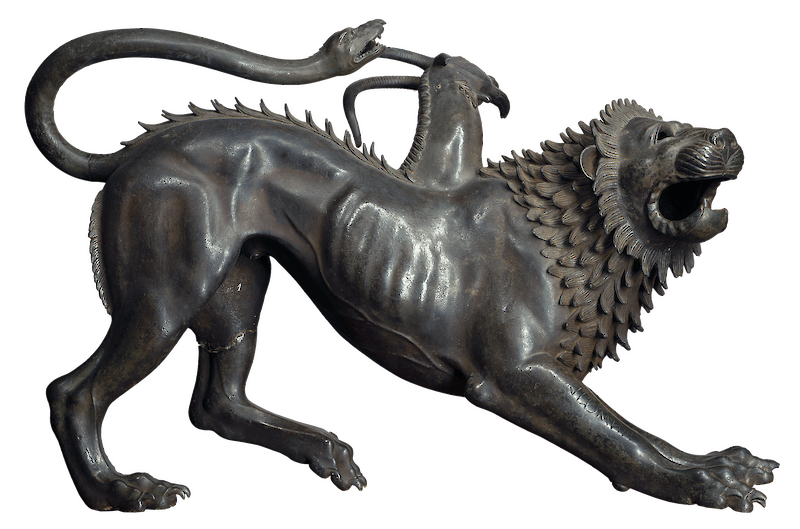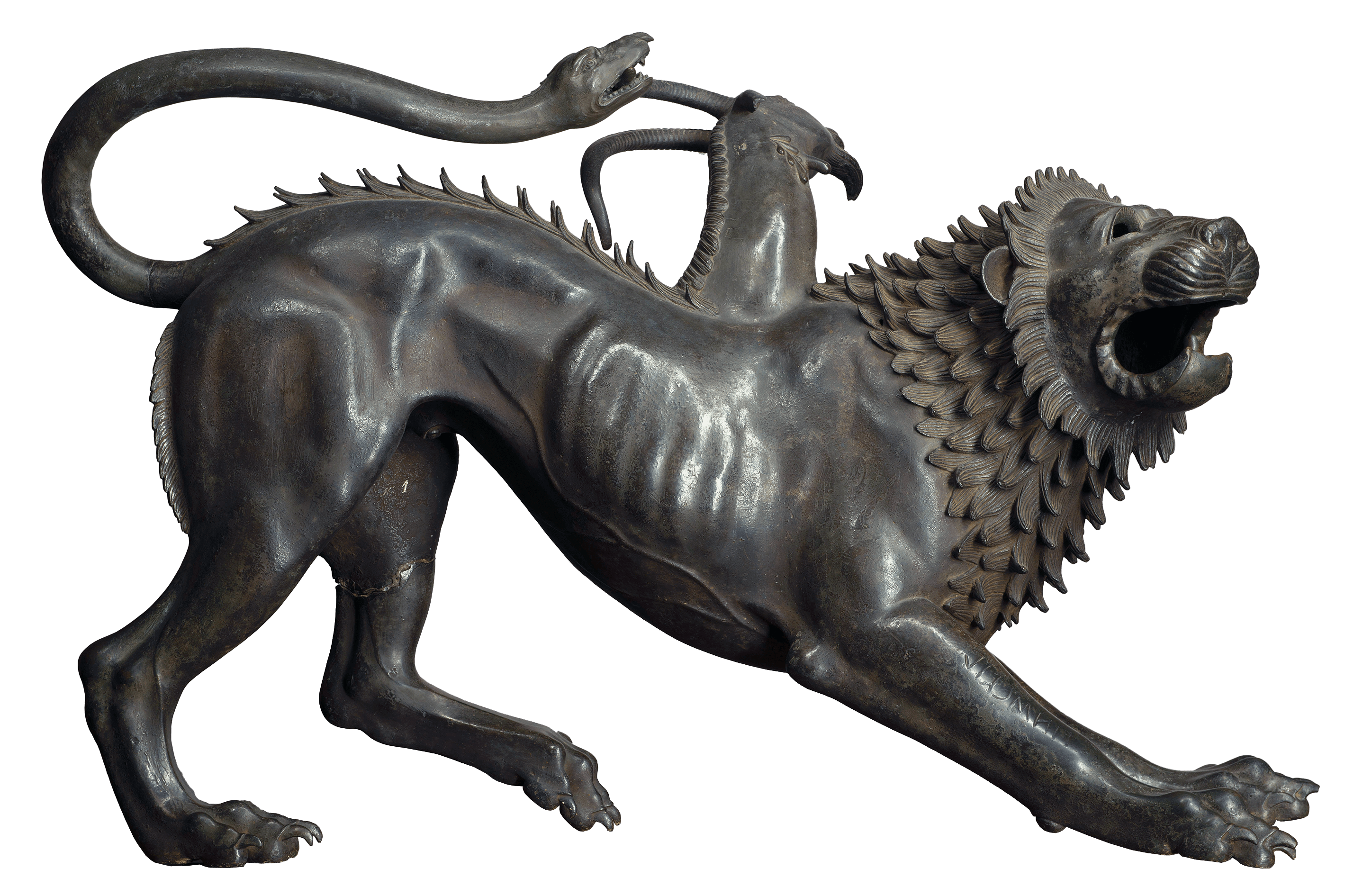


The chimera is only about two and a half feet high and a smidge over four feet long. A medium sized dog. But it feels monumental. I’m not really sure why. It could be the detail, the ribs arched under taught skin, it’s big knuckled paws clenched for traction. Maybe it’s the face, stylized and perfect, like a Sumerian king. Maybe monumental is the wrong word. Heroic is closer. There is power here, vigor. Its spined hindquarters are arched, legs bulge with muscle and tendon in a motion of recoil. Though fearsome, the beast is on the defense, crouched against threat. Legs splayed, ready for evasion, mane flared like a patinated sun, and eyes cast upward toward an invisible assailant. Who doesn’t love an underdog?
This is an undeniably modern interpretation. The chimera, like most beasts of antiquity, was the bad guy. Child of the giant serpent Typhon and the half woman half snake Echidna (you know her from the Starbucks logo) the Chimera was an abominable thing, unnatural combination of lion and goat, with the head of a snake for a tail. Her brothers and sisters live in legend. The sphinx, blessed with at least partially human visage, a symbol of pragmatic wisdom and guardian of the sacred in both benevolent and malevolent forms. The many headed hydra was another child of Typhon and Echidna, as was Cerberus, three-headed good boy guardian of hades, and the bulletproof Nemean lion famously strangled by Hercules.
In the lee of its legendary siblings, the chimera’s place in history is underwhelming, blurred by its association with the b-tier hero Bellerophon. Bellerophon was a great monster slayer, mentioned alongside Hercules and Perseus—if you’re a big nerd. Bellerophon never really caught the neoclassical revival wave. Hercules had twelve dramatic labors, a video game boss rush of a mythos, but Bellerophon’s story was messy, passed down by a grandson who was dodgy on details. He murdered his brother, maybe, and was exiled to Argos where the queen Anteia accused him of attempting to rape her. (The story paints this as revenge for his rejection but #belivewomen). Unable to just kill his problematic guest King Proteus commissioned Bellerophon to slay the local unkillable menace, the fire breathing chimera.
If you don’t remember Bellerophon from history class that’s fair. It’s a tough name to pronounce, and frankly he’s a lot less interesting than the winged horse Pegasus that Athena gave him, a mount I still imagine in Lisa Frank neon pink.
In the end, Bellerophon slayed the chimera not through brute strength but by cruel ingenuity, tipping his spear in lead, and letting the firey breath of the chimera melt the metal down its own throat. Our chimera murdered itself.
Unfamiliar with sneaky tactics, King Proteus didn’t believe Bellerophon’s tale of conquest, and sent the dubious hero on more practical attacks on the neighboring Solymi people and the Agean amazons. Eventually, swollen with arrogance, Bellerophon attempted to fly Pegasus to Olympus itself, considering himself worthy of godhood. On the journey the hero toppled off his mount, and Pegasis became the pack mule for Zeus’s thunderbolts, and the hero tumbled into a thorn bush that left him blind and doomed to misery. Yikes.
This Etruscan chimera is speculated to be one part of an installation, the cowering antagonist opposite a triumphant hero and his winged steed. The dragon to the archetypal St. George. But history is a fickle filter, and the hero is long gone. The legendary horse is gone. All that remains is our antihero, taught, ready, for 2500 years.
Today the etruscans are a mysterious people, understood mostly through their trading relationship with the Hellenistic Greeks. On its discovery, our chimera’s tail had been lost, and it was thought to be a statue of a lion. Luckily for us, the grandfather of art history Vasari, tracked down the origin of the artwork, relating it to the stater coins that featured the mythological chimera, and proposing it as part of a scene with the slayer Bellerophon and his horse.
While most sculpture today is commissioned for public display or personal collection, one of the primary reasons for creator in ancient times was votive. Objects created to honor a diety. The chimera holds a clue, and inscription that reads TINSCVIL, a sort of short hand we believe means “Offering to Tinia” the Etruscan sky god, similar to the Greek Zeus or Roman Jupiter
...
Got questions, comments or corrections about Chimera of Arezzo? Join the conversation in our Discord, and if you enjoy content like this, consider becoming a member for exclusive essays, downloadables, and discounts in the Obelisk Store.
